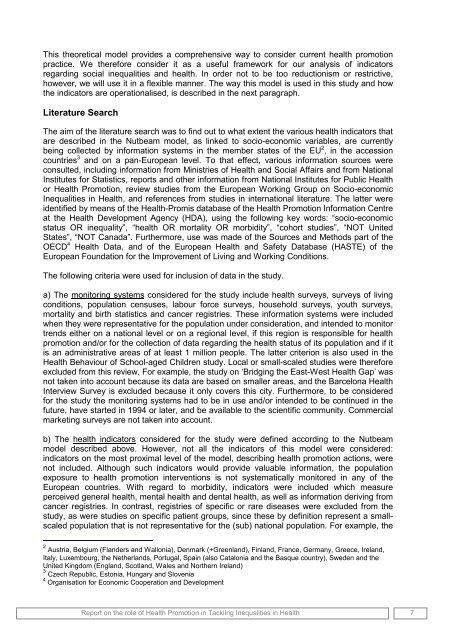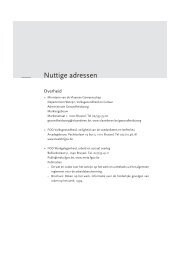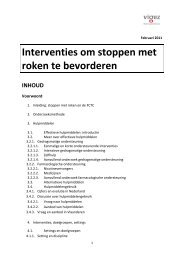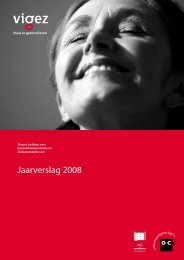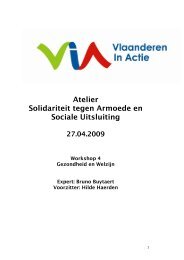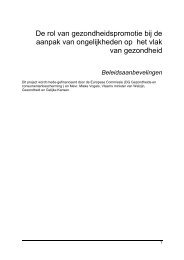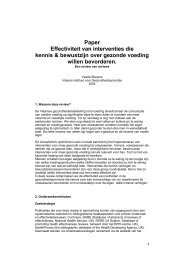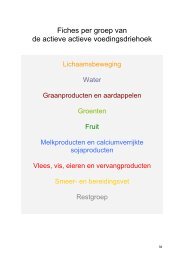Annex 1: Inventory of indicators from surveys and registries
Annex 1: Inventory of indicators from surveys and registries
Annex 1: Inventory of indicators from surveys and registries
Create successful ePaper yourself
Turn your PDF publications into a flip-book with our unique Google optimized e-Paper software.
This theoretical model provides a comprehensive way to consider current health promotion<br />
practice. We therefore consider it as a useful framework for our analysis <strong>of</strong> <strong>indicators</strong><br />
regarding social inequalities <strong>and</strong> health. In order not to be too reductionism or restrictive,<br />
however, we will use it in a flexible manner. The way this model is used in this study <strong>and</strong> how<br />
the <strong>indicators</strong> are operationalised, is described in the next paragraph.<br />
Literature Search<br />
The aim <strong>of</strong> the literature search was to find out to what extent the various health <strong>indicators</strong> that<br />
are described in the Nutbeam model, as linked to socio-economic variables, are currently<br />
being collected by information systems in the member states <strong>of</strong> the EU 2 , in the accession<br />
countries 3 <strong>and</strong> on a pan-European level. To that effect, various information sources were<br />
consulted, including information <strong>from</strong> Ministries <strong>of</strong> Health <strong>and</strong> Social Affairs <strong>and</strong> <strong>from</strong> National<br />
Institutes for Statistics, reports <strong>and</strong> other information <strong>from</strong> National Institutes for Public Health<br />
or Health Promotion, review studies <strong>from</strong> the European Working Group on Socio-economic<br />
Inequalities in Health, <strong>and</strong> references <strong>from</strong> studies in international literature. The latter were<br />
identified by means <strong>of</strong> the Health-Promis database <strong>of</strong> the Health Promotion Information Centre<br />
at the Health Development Agency (HDA), using the following key words: “socio-economic<br />
status OR inequality”, “health OR mortality OR morbidity”, “cohort studies”, “NOT United<br />
States”, “NOT Canada”. Furthermore, use was made <strong>of</strong> the Sources <strong>and</strong> Methods part <strong>of</strong> the<br />
OECD 4 Health Data, <strong>and</strong> <strong>of</strong> the European Health <strong>and</strong> Safety Database (HASTE) <strong>of</strong> the<br />
European Foundation for the Improvement <strong>of</strong> Living <strong>and</strong> Working Conditions.<br />
The following criteria were used for inclusion <strong>of</strong> data in the study.<br />
a) The monitoring systems considered for the study include health <strong>surveys</strong>, <strong>surveys</strong> <strong>of</strong> living<br />
conditions, population censuses, labour force <strong>surveys</strong>, household <strong>surveys</strong>, youth <strong>surveys</strong>,<br />
mortality <strong>and</strong> birth statistics <strong>and</strong> cancer <strong>registries</strong>. These information systems were included<br />
when they were representative for the population under consideration, <strong>and</strong> intended to monitor<br />
trends either on a national level or on a regional level, if this region is responsible for health<br />
promotion <strong>and</strong>/or for the collection <strong>of</strong> data regarding the health status <strong>of</strong> its population <strong>and</strong> if it<br />
is an administrative areas <strong>of</strong> at least 1 million people. The latter criterion is also used in the<br />
Health Behaviour <strong>of</strong> School-aged Children study. Local or small-scaled studies were therefore<br />
excluded <strong>from</strong> this review. For example, the study on ‘Bridging the East-West Health Gap’ was<br />
not taken into account because its data are based on smaller areas, <strong>and</strong> the Barcelona Health<br />
Interview Survey is excluded because it only covers this city. Furthermore, to be considered<br />
for the study the monitoring systems had to be in use <strong>and</strong>/or intended to be continued in the<br />
future, have started in 1994 or later, <strong>and</strong> be available to the scientific community. Commercial<br />
marketing <strong>surveys</strong> are not taken into account.<br />
b) The health <strong>indicators</strong> considered for the study were defined according to the Nutbeam<br />
model described above. However, not all the <strong>indicators</strong> <strong>of</strong> this model were considered:<br />
<strong>indicators</strong> on the most proximal level <strong>of</strong> the model, describing health promotion actions, were<br />
not included. Although such <strong>indicators</strong> would provide valuable information, the population<br />
exposure to health promotion interventions is not systematically monitored in any <strong>of</strong> the<br />
European countries. With regard to morbidity, <strong>indicators</strong> were included which measure<br />
perceived general health, mental health <strong>and</strong> dental health, as well as information deriving <strong>from</strong><br />
cancer <strong>registries</strong>. In contrast, <strong>registries</strong> <strong>of</strong> specific or rare diseases were excluded <strong>from</strong> the<br />
study, as were studies on specific patient groups, since these by definition represent a smallscaled<br />
population that is not representative for the (sub) national population. For example, the<br />
2<br />
Austria, Belgium (Fl<strong>and</strong>ers <strong>and</strong> Wallonia), Denmark (+Greenl<strong>and</strong>), Finl<strong>and</strong>, France, Germany, Greece, Irel<strong>and</strong>,<br />
Italy, Luxembourg, the Netherl<strong>and</strong>s, Portugal, Spain (also Catalonia <strong>and</strong> the Basque country), Sweden <strong>and</strong> the<br />
United Kingdom (Engl<strong>and</strong>, Scotl<strong>and</strong>, Wales <strong>and</strong> Northern Irel<strong>and</strong>)<br />
3<br />
Czech Republic, Estonia, Hungary <strong>and</strong> Slovenia<br />
4<br />
Organisation for Economic Cooperation <strong>and</strong> Development<br />
Report on the role <strong>of</strong> Health Promotion in Tackling Inequalities in Health<br />
7


